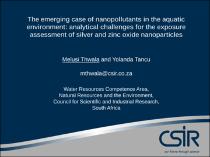 ResearchSpace
ResearchSpace
The emerging case of nanopollutants in the aquatic environment: analytical challenges for the exposure assessment of silver and zinc oxide nanoparticles
JavaScript is disabled for your browser. Some features of this site may not work without it.
- ResearchSpace
- →
- Research Publications/Outputs
- →
- Conference Publications
- →
- View Item
| dc.contributor.author |
Thwala, Melusi

|
|
| dc.contributor.author |
Tancu, Yolanda

|
|
| dc.date.accessioned | 2017-06-07T07:09:51Z | |
| dc.date.available | 2017-06-07T07:09:51Z | |
| dc.date.issued | 2016-09 | |
| dc.identifier.citation | Thwala, M. and Tancu, Y. 2016. The emerging case of nanopollutants in the aquatic environment: analytical challenges for the exposure assessment of silver and zinc oxide nanoparticles. Innovation In Environmental Monitoring, University of York, York, 21-22 September 2016 | en_US |
| dc.identifier.uri | http://hdl.handle.net/10204/9169 | |
| dc.description | Innovation In Environmental Monitoring, University of York, York, 21-22 September 2016 | en_US |
| dc.description.abstract | The growing number of nano-enabled products and technologies suggests likelihood increase of nanopollutants into the environment, a trend that is anticipated to increase further as nanotechnology expands. Nanopollutants are considered a case of emerging environmental contaminants partly due to limited capability to detect and quantify them in environmental matrices. The current paper presents findings from the exposure assessments of silver and zinc oxide nanoparticles (Ag and ZnO NPs) in synthetic and environmental water samples. A suite of commonly used techniques for the determination of size distribution (TEM, zetasizer, NTA), morphology (TEM), stability (UV-vis), dissolution (ICP-MS) and particle concentration (NTA) were applied. For size determination in situ each technique performed fairly well in synthetic media, but all had limitations in river and waste water samples. The presence of background media particles in environmental samples weakened the accuracy of the NTA in deriving both the size distribution and particle number concentration. The determination of soluble metallic forms was influenced by media background concentrations and seperation technique employed. In light of the analytical challenges and the low predicted environmental concentrations of nanopollutants, we propose site specificity for the risk assessment of nano-enabled products. | en_US |
| dc.language.iso | en | en_US |
| dc.relation.ispartofseries | Worklist;17843 | |
| dc.subject | Nanopollutants | en_US |
| dc.title | The emerging case of nanopollutants in the aquatic environment: analytical challenges for the exposure assessment of silver and zinc oxide nanoparticles | en_US |
| dc.type | Conference Presentation | en_US |
| dc.identifier.apacitation | Thwala, M., & Tancu, Y. (2016). The emerging case of nanopollutants in the aquatic environment: analytical challenges for the exposure assessment of silver and zinc oxide nanoparticles. http://hdl.handle.net/10204/9169 | en_ZA |
| dc.identifier.chicagocitation | Thwala, Melusi, and Yolanda Tancu. "The emerging case of nanopollutants in the aquatic environment: analytical challenges for the exposure assessment of silver and zinc oxide nanoparticles." (2016): http://hdl.handle.net/10204/9169 | en_ZA |
| dc.identifier.vancouvercitation | Thwala M, Tancu Y, The emerging case of nanopollutants in the aquatic environment: analytical challenges for the exposure assessment of silver and zinc oxide nanoparticles; 2016. http://hdl.handle.net/10204/9169 . | en_ZA |
| dc.identifier.ris | TY - Conference Presentation AU - Thwala, Melusi AU - Tancu, Yolanda AB - The growing number of nano-enabled products and technologies suggests likelihood increase of nanopollutants into the environment, a trend that is anticipated to increase further as nanotechnology expands. Nanopollutants are considered a case of emerging environmental contaminants partly due to limited capability to detect and quantify them in environmental matrices. The current paper presents findings from the exposure assessments of silver and zinc oxide nanoparticles (Ag and ZnO NPs) in synthetic and environmental water samples. A suite of commonly used techniques for the determination of size distribution (TEM, zetasizer, NTA), morphology (TEM), stability (UV-vis), dissolution (ICP-MS) and particle concentration (NTA) were applied. For size determination in situ each technique performed fairly well in synthetic media, but all had limitations in river and waste water samples. The presence of background media particles in environmental samples weakened the accuracy of the NTA in deriving both the size distribution and particle number concentration. The determination of soluble metallic forms was influenced by media background concentrations and seperation technique employed. In light of the analytical challenges and the low predicted environmental concentrations of nanopollutants, we propose site specificity for the risk assessment of nano-enabled products. DA - 2016-09 DB - ResearchSpace DP - CSIR KW - Nanopollutants LK - https://researchspace.csir.co.za PY - 2016 T1 - The emerging case of nanopollutants in the aquatic environment: analytical challenges for the exposure assessment of silver and zinc oxide nanoparticles TI - The emerging case of nanopollutants in the aquatic environment: analytical challenges for the exposure assessment of silver and zinc oxide nanoparticles UR - http://hdl.handle.net/10204/9169 ER - | en_ZA |





